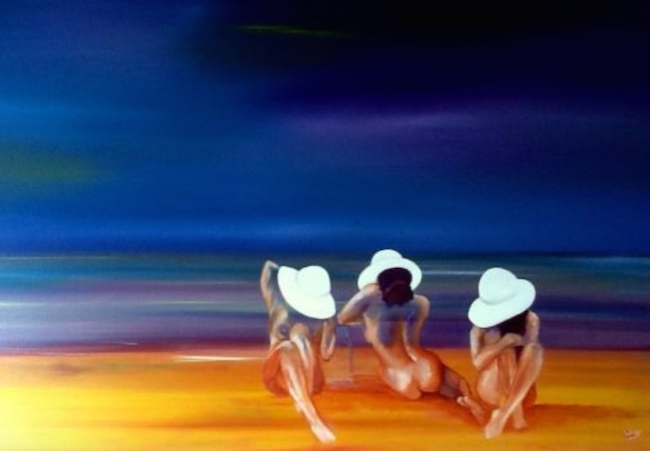Nel mondo dell’arte moderna e contemporanea la rilevanza del descrivere le emozioni è emersa in maniera incisiva e decisa, proprio per dare all’espressione visiva quel fondamentale collegamento con un mondo interiore che molto spesso a malapena necessitava della forma visibile per narrare l’intensità di una sensazione percepita. Nel caso del protagonista di oggi l’emozione diviene impalpabile, un universo a metà tra la realtà e il ricordo in cui i confini sono sfumati e le sensazioni amplificate.
Il movimento dell’Espressionismo, anticipato dalle idee del gruppo dei Fauves francesi, nacque per dar modo agli artisti che vi aderirono, di trovare un canale creativo che desse maggiore importanza all’universo interiore dell’esecutore dell’opera facendolo sentire libero dalle regole estetiche che legavano l’arte figurativa all’attinenza con la realtà osservata; in virtù di questo inedito modo di intendere l’approccio alla tela i colori divennero intensi e reali, nonché protagonisti assoluti nella descrizione delle emozioni che dovevano fuoriuscire e avvolgere l’osservatore. Anche le regole accademiche della prospettiva, della profondità e del chiaroscuro vennero completamente sovvertite e travolte dall’impeto di quel mondo di sensazioni da cui gli artisti si lasciavano travolgere e per cui fondamentale era l’accostamento cromatico che in qualche modo doveva scuotere gli animi e manifestare la sostanza dell’emozione, la sua forza, la sua intensità. Per contenere le forme distanti da quelle visibili nella realtà e per enfatizzare il senso di distacco dalla contingenza per entrare nel campo del puro sentire, i Fauves introdussero dei contorni netti spesso con colori forti necessari a definire l’immagine raccontata, contorni che in alcuni maestri dell’Espressionismo divennero meno incisivi, più sottili o più incorporati nelle scene e nei personaggi raffigurati. Dai pittoreschi e improbabili paesaggi a tinte forti di André Derain e i ritratti dai contorni e dai tratti definiti di Henri Matisse, si passò all’Espressionismo tormentato e cupo di Edvard Munch o a quello esplorativo e a tratti sensuale di Ernst Ludwig Kirchner, in cui pur restando la gamma cromatica completamente distaccata da ciò che lo sguardo osserva nella realtà, tuttavia tendono verso un’attenuazione dell’intensità dei colori e il loro accostamento diviene più contiguo, meno contrastante rispetto alle tinte dei Fauves. L’intenzione pittorica però era la medesima, quella cioè di mettere in secondo piano l’attitudine estetica verso il Realismo che aveva dominato il secolo precedente, e di lasciare che fossero i colori a dettare le regole sulla tela, quelli davanti a cui il tratto figurativo sembrava essere una pura conseguenza, un comprimario necessario solo a far comprendere in modo chiaro il messaggio al fruitore dell’opera. Nell’era contemporanea le emozioni assumono forme e spessori differenti, così come gli stili si sovrappongono e si mescolano per dare origine a inedite cifre espressive in grado non solo di tracciare nuovi percorsi, ma di dare un’impronta del tutto personale al sentire dell’artista. Han de Leeuwerk, artista olandese di forte personalità comunicativa, affronta l’Espressionismo in maniera nuova, senza la necessità di gridare le proprie emozioni bensì lasciando che fuoriescano lievemente, come se fossero la manifestazione di un sogno, la traccia di una memoria che resta indelebile davanti al suo sguardo.
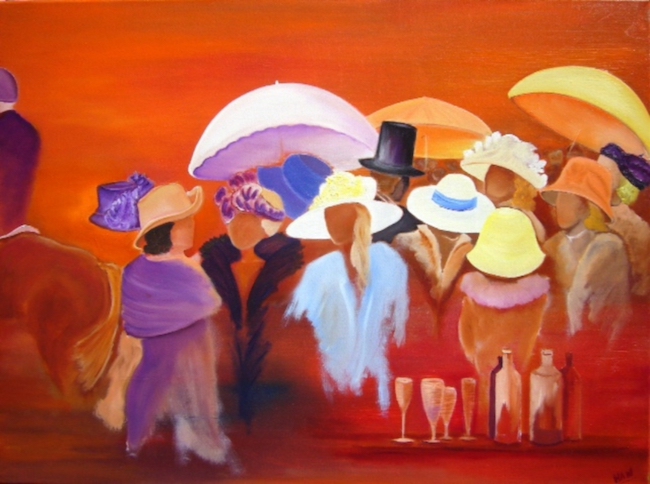
La dissolvenza delle immagini, seppur con contorni nitidamente delineati, contribuisce a infondere nell’osservatore una sensazione di leggerezza, di lievità di sensazioni che, pur essendo incisive e incancellabili, non hanno bisogno di travolgere lo sguardo, non necessitano di scuotere gli animi bensì semplicemente li carezzano, li coinvolgono dolcemente all’interno del mondo emozionale dei personaggi ma anche dell’artista.
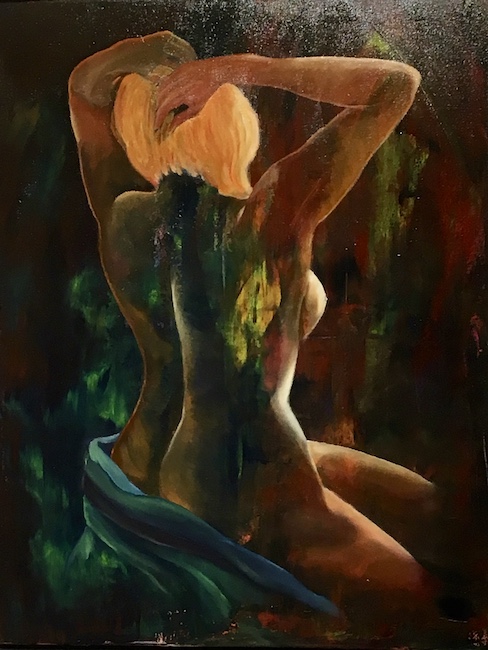
La gamma cromatica di de Leeuwerk si modifica sulla base delle scene narrate e appare così più cipriata e terrosa quando descrive sensazioni intime, riflessioni, desideri, e si fa più solare e luminosa quando si lascia colpire dalla luce, da un paesaggio e da ciò che ne fa parte, raccontandolo quasi in maniera metafisica, oppure diviene più vivace e variopinta quando rappresenta momenti di convivialità, di piacevolezza nell’incontro e nello stare insieme che appartiene da sempre all’essere umano.
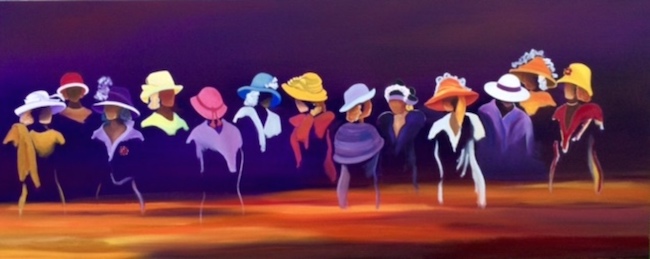
Quest’ultima esuberanza cromatica contraddistingue l’opera Ladies day (Il giorno delle donne) in cui il cielo irrazionalmente viola e la terra sottostante fanno da palcoscenico e da comprimari all’essenza stessa della femminilità, quell’essere sospese tra mente e anima, tra praticità e romanticismo, che la sensibilità di de Leeuwerk è in grado di cogliere e di imprimere sulla tela; la trasparenza dei corpi, così come l’assenza dei dettagli dei volti contribuisce a infondere la sensazione di delicatezza che accompagna e contraddistingue il mondo femmineo, civettuolo quanto profondo, emotivo quanto pragmatico qualora le situazioni lo richiedano.
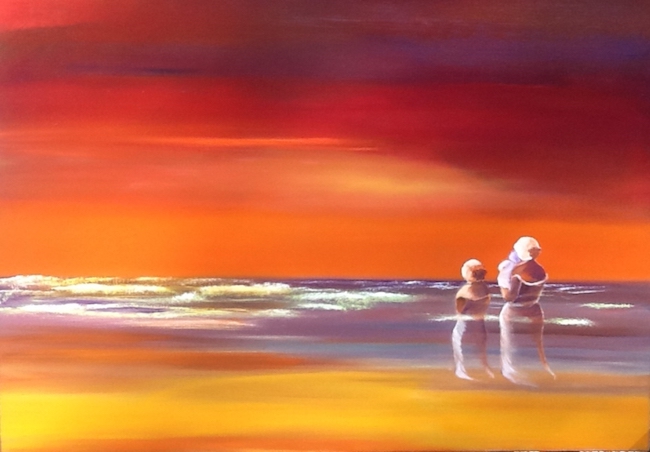
In Endless (Senza fine) invece, opera molto più legata a una sensazione poetica, emozionale, quel senza fine a cui ciascun individuo tende, sperando di incontrare la magia che riesca a rendere incancellabile un sentimento, lo stile di de Leeuwerk si sposta verso il Metafisico, infondendo nell’osservatore al tempo stesso il senso di speranza e di trepidante attesa ma anche il fascino silenzioso del paesaggio osservato, quel luogo indefinito all’interno del quale tutto può accadere. La particolare impalpabilità delle figure si rafforza in questa tela, l’evanescenza contribuisce a rappresentare l’onda lunga del prosieguo di un sentimento, un amore materno che è forse l’unico ad avere la caratteristica di perdurare per tutto il corso dell’esistenza.
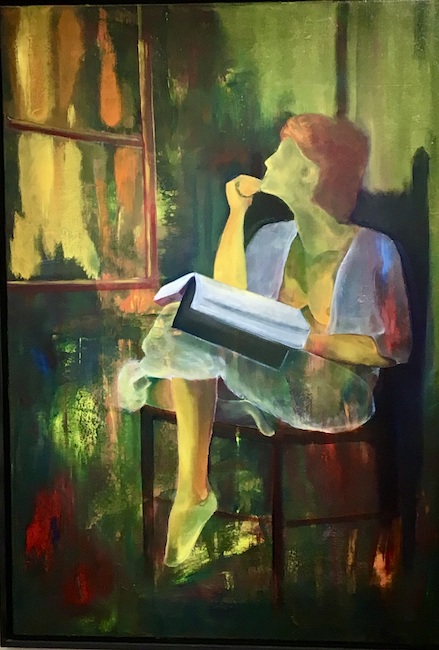
In Desiring (Desiderando) l’artista si addentra nella mente e nell’anima della donna raffigurata, ne interpreta lo sguardo e la posizione volta al ricordo di un tempo lontano, che è rimasto galleggiante nella sua interiorità e che si manifesta sotto forma di nostalgia; le tonalità in quest’opera sono più terrose, più intimiste mentre la definizione della protagonista è maggiore, quasi come se l’intensità del sentire rendesse più solida la sua presenza nel contesto della tela, come se le emozioni ne concretizzassero e ne definissero la personalità, l’essenza interiore.
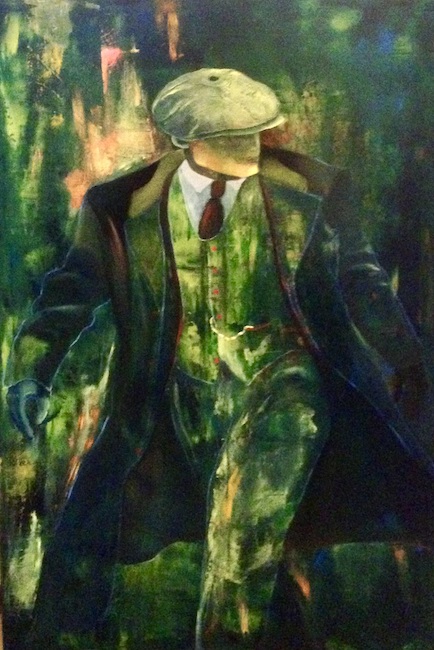
Così come in Peaky Eli Han de Leeuwerk lascia andare la memoria a un tempo lontano, gli anni Trenta, durante i quali l’eleganza faceva parte della quotidianità, così come importante era la gentilezza mista alla forza, quell’essenza maschile che fuoriesce dalla posa del protagonista dell’opera e che l’artista avvolge di tonalità muschiate, raffinate e al tempo stesso nostalgiche nei confronti di un periodo durante il quale tutto era più definito, più semplicemente interpretabile. Anche in questo caso la maggiore definizione del personaggio contribuisce a enfatizzare la sua personalità, il suo incedere sicuro che lascia trasparire un approccio determinato nei confronti della vita e della quotidianità, proprio come la società dell’epoca si sarebbe aspettata dal mondo maschile.
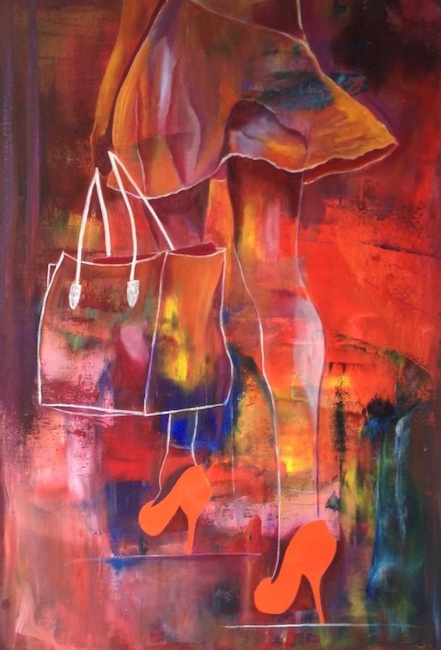
La capacità di dare la visione corale dell’insieme è uno dei tratti distintivi di questo incredibile artista, che tuttavia riesce a focalizzare l’attenzione dell’osservatore su un punto preciso della tela oppure su un singolo dettaglio, come nel lavoro Red Shoes, in cui l’evanescenza della figura è composta ad arte per mettere in risalto le scarpe rosse di cui parla il titolo, quel simbolo di vanitosa femminilità da cui l’artista non riesce a smettere di lasciarsi affascinare. Nel corso della sua carriera Han de Leeuwerk ha esposto le sue opere in tutto il mondo tra cui la Miami Art Fair, Arte Monaco, e poi ancora Londra e, ovviamente, in vari eventi in Olanda.
HAN DE LEEUWERK-CONTATTI
Email: leeuwerk@yahoo.com
Sito web: https://www.handeleeuwerkkunst.nl/
Facebook: https://www.facebook.com/han.deleeuwerk
https://www.facebook.com/HandeleeuwerkKunst
The fading of emotions in the artworks of Han de Leeuwerk
In the world of modern and contemporary art, the importance of describing emotions has emerged in an incisive and decisive manner, precisely in order to give visual expression that fundamental link with an inner world that very often barely needed visible form to narrate the intensity of a perceived sensation. In the case of today’s protagonist, emotion becomes impalpable, a universe somewhere between reality and memory in which boundaries are blurred and sensations amplified.
The Expressionist movement, anticipated by the ideas of the French Fauves group, was born to allow the artists who adhered to it to find a creative channel that gave greater importance to the inner universe of the work’s creator, making him feel free from the aesthetic rules that bound figurative art to the connection with the observed reality. By virtue of this new way of understanding the approach to the canvas, colours became intense and real, as well as absolute protagonists in the description of the emotions that had to escape and envelop the observer. Even the academic rules of perspective, depth and chiaroscuro were completely overturned and swept away by the impetus of that world of sensations that artists allowed themselves to be swept away by and for which the colour combination was fundamental, which in some way had to shake the soul and manifest the substance of the emotion, its strength, its intensity. In order to contain the forms that were distant from those visible in reality and to emphasise the sense of detachment from contingency to enter into the field of pure feeling, the Fauves introduced sharp outlines, often in the strong colours necessary to define the image told, outlines that in some Expressionist masters became less incisive, more subtle or more embedded in the scenes and characters depicted.
From André Derain’s picturesque and improbable landscapes in strong colours and Henri Matisse’s portraits with defined outlines and features, we move on to Edvard Munch’s tormented and sombre Expressionism or to Ernst Ludwig Kirchner’s exploratory and sometimes sensual one, in which, although the colour palette remained completely detached from what the eye observed in reality, they tended towards a toning down of the intensity of the colours and their juxtaposition became more contiguous, less contrasting than the hues of the Fauves. The pictorial intention, however, was the same, that is to say to put in the background the aesthetic attitude towards Realism that had dominated the previous century, and to let the colours dictate the rules on the canvas, those in front of which the figurative line seemed to be a pure consequence, a comprimario necessary only to make the message clear to the user of the artwork. In the contemporary era, emotions take on different forms and thicknesses, just as styles overlap and mix to give rise to new expressive figures capable not only of tracing new paths, but also of giving an entirely personal imprint to the artist’s feelings. Han de Leeuwerk, a Dutch artist with a strong communicative personality, tackles Expressionism in a new way, without the need to shout out his emotions, but rather letting them emerge lightly, as if they were the manifestation of a dream, the trace of a memory that remains indelibly in front of his eyes. The fading of the images, although with clearly defined outlines, helps to instil in the observer a feeling of lightness, of the levity of sensations which, although they are incisive and indelible, do not need to overwhelm the gaze, do not need to shake the souls but simply caress them, gently involving them in the emotional world of the characters but also of the artist.
De Leeuwerk’s chromatic range changes according to the scenes narrated and thus appears more powdery and earthy when he describes intimate feelings, reflections and desires, and becomes sunnier and brighter when he lets himself be struck by the light, by a landscape and by what is part of it, recounting it almost in a metaphysical way, or becomes more lively and multicoloured when he represents moments of conviviality, of pleasantness in meeting and being together that has always belonged to human beings. This chromatic exuberance distinguishes the painting Ladies day in which the irrationally violet sky and the earth below act as a stage and as supporting characters for the very essence of femininity, that being suspended between mind and soul, between practicality and romanticism, which de Leeuwerk’s sensitivity is able to capture and imprint on the canvas; the transparency of the bodies, as well as the absence of details on the faces, contributes to instilling the sensation of delicacy that accompanies and distinguishes the feminine world, coquettish as well as profound, emotional as well as pragmatic when situations require it. In Endless, on the other hand, a work much more closely linked to a poetic, emotional sensation, that endlessness to which each individual strives, hoping to find the magic that can make a feeling indelible, de Leeuwerk’s style shifts towards the metaphysical, instilling in the observer both a sense of hope and anxious expectation and also the silent charm of the landscape observed, that undefined place within which anything can happen. The particular impalpability of the figures is reinforced in this canvas, the evanescence helps to represent the long wave of the continuation of a feeling, a maternal love that is perhaps the only one to have the characteristic of lasting throughout existence.
In Desiring, the artist delves into the mind and soul of the woman depicted, interpreting her gaze and her position aimed at the memory of a distant time, which has remained floating in her interiority and which manifests itself in the form of nostalgia; the tones in this artwork are earthier, more intimate, while the definition of the protagonist is greater, almost as if the intensity of her feelings made her presence in the context of the canvas more solid, as if her emotions concretised and defined her personality, her interior essence. Just as in Peaky Eli, Han de Leeuwerk lets his memory go back to a distant time, the 1930s, when elegance was part of everyday life, just as important was gentleness mixed with strength, that masculine essence which emerges from the pose of the protagonist of the painting and which the artist envelops in musky tones, refined and at the same time nostalgic for a period when everything was more defined, more simply interpretable. Here too, the greater definition of the character helps to emphasise his personality, his confident gait that reveals a determined approach to existance and everyday life, just as society at the time would have expected from the male world. The ability to give a choral vision of the whole is one of the distinctive traits of this incredible artist, who nevertheless manages to focus the observer’s attention on a precise point of the canvas or on a single detail, as in the canvas Red Shoes, in which the evanescence of the figure is artfully composed to highlight the red shoes of which the title speaks, that symbol of vain femininity by which the artist cannot stop being fascinated. Throughout his career, Han de Leeuwerk has exhibited his artworks all over the world, including at the Miami Art Fair, Arte Monaco, London and, of course, at various events in the Netherlands.


